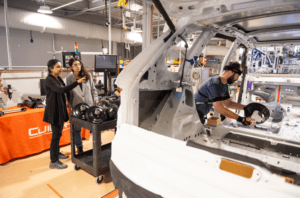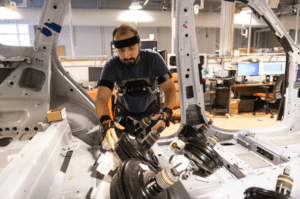Divya Srinivasan of Clemson University and her team are wrapping up the fall semester with several new awards that solidify their leadership in ergonomics research. Her specific focus is on occupational exoskeletons.
Srinivasan, who serves as the McQueen Quattlebaum Professor of Industrial Engineering, received the HFE WOMAN Woman of the Year Award in October at the 67th International Annual Meeting of the Human Factors and Ergonomics Society (HFES).

The honor recognizes the outstanding contribution made by an individual woman or team of women to the human factors and ergonomics community through research, academia and/or service.
At the same annual HFES meeting, another award shined the spotlight on Zeinab Kazemi, a postdoctoral scholar working with Srinivasan. The Occupational Ergonomics Technical Group of HFES recognized Kazemi for having the Best Computational Paper.
The paper is titled, “Differences in kinematics and resulting lumbar spinal forces during repetitive lifting tasks: simulation versus estimation of the effects of wearing a back-support exoskeleton.” Co-authors included Jang-Ho Park and Srinivasan.
Srinivasan’s doctoral advisee, Satyajit Upasani, was also awarded the Best Student Paper Award from the Augmented Cognition Technical Group of HFES for his paper titled “Gaze Behavior and Mental Workload While Using a Whole-Body Powered Exoskeleton: A Pilot Study.”
Earlier in October, Srinivasan received the McQueen Quattlebaum Faculty Achievement Award from Clemson’s College of Engineering, Computing and Applied Sciences. The award recognizes faculty accomplishments in the preceding year, and distinctions and awards over the past three years.
In August, Srinivasan and her team won the Presentation Competition Award at the Exo Games 2023, an international event held in London by The University of Central Lancashire and ASTM International’s Center of Excellence. The Clemson team also took third place in the overall design competition.

Srinivasan, whose research focus is on biomechanics and ergonomics, said the accolades feel awesome and that her work in exoskeletons has been continuously growing in recent years.
“I think the research issues are so fantastic,” she said. “They span from fundamental inquiries about how the brain regulates muscles when a worker utilizes an external suit for assistance, to exploring the safety culture within organizations and its influence on the adoption of exoskeletons by workers. There is such a range of questions. Many of them I can’t tackle on my own, and I need to collaborate with really cool people from around the country and around the world. I love research.”
In the wake of her honors, Srinivansan received high praise from several Clemson officials, including Kevin Taaffe, chair of the Department of Industrial Engineering.
“Dr. Srinivasan’s leadership and the groundbreaking work of her team in exoskeleton research embody the core principles that drive the department’s success,” Taaffe said. “Her achievements, including the recent awards, are a testament to our commitment to research ascension, improving lives and providing exemplary educational experiences.”
Congratulations also came from Anand Gramopadhye, dean of the College of Engineering, Computing and Applied Sciences.
“Dr. Srinivasan is an outstanding researcher and scholar whose recent awards underscore her passion for advancing the frontiers of human factors and ergonomics,” Gramopadhye said. “Through her remarkable contributions, she exemplifies the college’s dedication to fostering a premier student experience, advancing research and positively transforming lives not only in South Carolina but far beyond our campus.”
As the end of the semester neared, Srinivasan sat down for an interview in which she reflected on her research, considered what could be holding back exoskeletons from more widespread use and gave her best prediction for the future of the technology.
I think a lot of people might think of movies such as “Ironman” or “Aliens” when they hear about exoskeletons. But what is a good real-world layperson’s definition of an exoskeleton?
An exoskeleton is literally a skeleton outside your body. Any external structure that gives your body support is technically called an exoskeleton. Can we give humans machine-like power through structures that can be intimately worn on their bodies? That’s the whole concept of exoskeletons. The primary focus of our research is on exoskeletons that are designed to be worn in occupational contexts, to prevent overexertion injuries that occur due to performing physically demanding tasks, such as those in manufacturing and healthcare.
What sort of questions are you asking in your research?
The early days were mostly focused on maturing the technology– making it lighter, fit the body better, less hot, and more comfortable. A lot of technological advances have been happening. Now that the technology is maturing, the big question is why we are not implementing it at large scale yet. Where’s the gap? What have we not understood about the impacts exoskeletons can have on our body, in the short, and long-terms? Why aren’’t large manufacturers using these exoskeletons in the hundreds or thousands? Those are the questions we’re trying to answer. Outside of exoskeletons designed for work, we have a collaboration with Prisma Health Roger C. Peace Rehabilitation Hospital looking at spinal cord injuries. The principal investigator is Jessica Avilés, who was a postdoctoral fellow in my group before becoming an assistant professor of industrial engineering, also at Clemson.
What advantages do human beings in exoskeletons have over autonomous robots?
We keep talking to manufacturing folks, and there are several jobs that they don’t see getting automated in the next decade or two for various reasons. I don’t think industry has been hesitant because of the automation factor or cost factor. The questions we hear are: Will my workers wear exoskeletons? And if they wear them for long enough, will we see some positive effects on performance, fatigue, or injury risk? They are looking to impact safety and reduce worker compensation and turnover in their workforce.
Is the only way to measure exoskeleton effectiveness to put them on workers and see what happens to them over five to 10 years?
Well, most over-exertion injuries are cumulative in nature, so they don’t happen in a day, and some may years to develop. But having said that, no, we don’t have to wait for years to understand exoskeletons can have a positive impact on workers or not. We can do some quantitative risk modeling based on what we know about the body, human behaviors, and injuries, and we are trying to do that. But we still need a reasonable amount of data to make those predictions meaningful, and that’s one of the things we’re after.
Where do you see exoskeleton technology headed in the next 10 years?
My optimistic prediction is that the concept of exoskeletons becomes ubiquitous. You would be able to go into a store and pick out your choice of exoskeleton, from a variety of device types. Depending on what you wanted to do, say do yard work or clean or go for a long hike, you would be able to find an affordable device that would easily conform to your body or even attach to your clothes. That would be for the consumer. In industry, depending on the kind of job you have and who you are as a worker, there may be a device that would be waiting for you, to reduce the physical strain on the body. The pessimistic viewpoint is maybe this is a cool concept, but we are still far away from prime time, and there may be no universal design that can accommodate individuals, tasks, and other factorsly. Probably the realistic view is somewhere between those two, with some limited applications being more ready for implementation in the near future that others.
Get in touch and we will connect you with the author or another expert.
Or email us at news@clemson.edu

